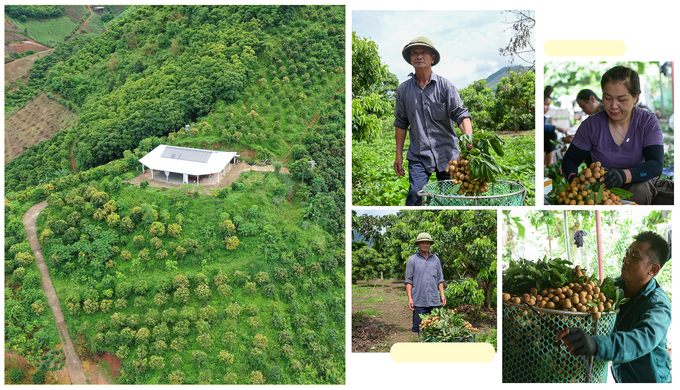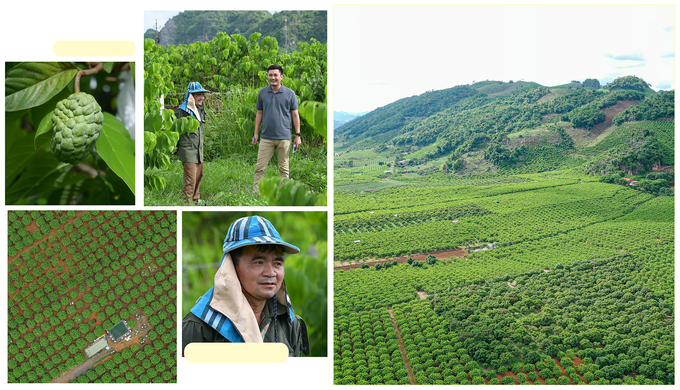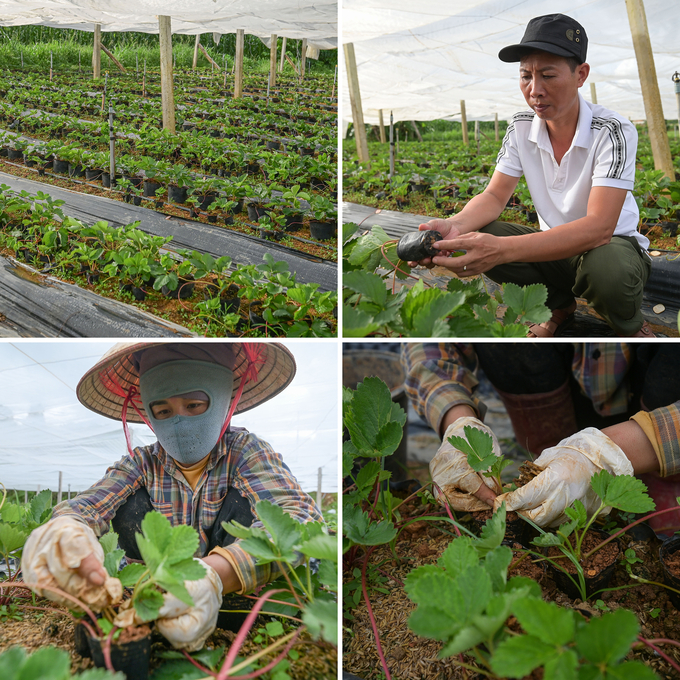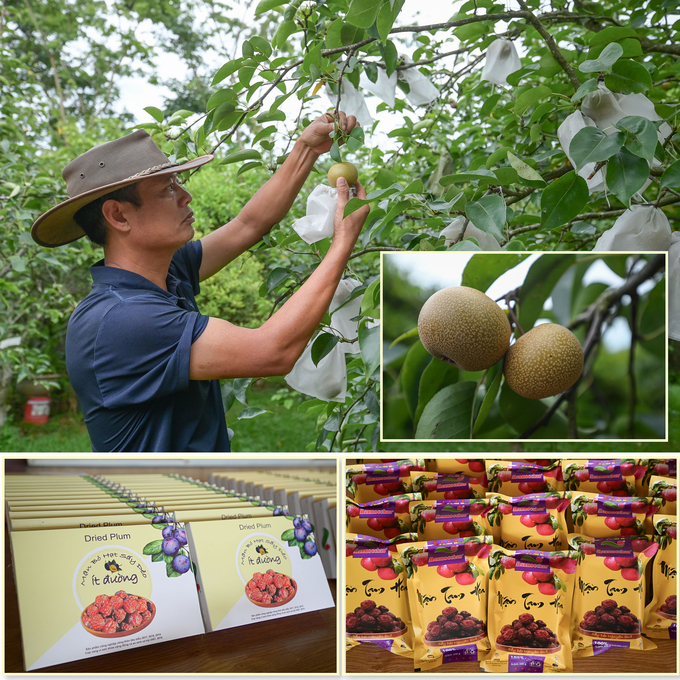May 24, 2025 | 10:15 GMT +7
May 24, 2025 | 10:15 GMT +7
Hotline: 0913.378.918
May 24, 2025 | 10:15 GMT +7
Hotline: 0913.378.918
In response to the series of articles titled "Son La, a Decade of Hill Climbing" published in the Vietnam Agriculture Newspaper, Mr. Le Quoc Doanh said: "From the perspective of a man who has spent over 30 years engaging with Son La and the Northern mountainous area in various roles, I believe that the accomplishments of Son La agriculture today are the result of a combination of factors.
"The human factor is the most significant and distinctive factor," stated Mr. Le Quoc Doanh.
Mr. Le Quoc Doanh employed the word to characterize the emotions associated with the story of Son La agriculture's success today.
These are the words of Mr. Le Quoc Doanh, who is conveying his sentiments regarding the accomplishments of Son La agriculture today. Every return to this hilly land is met with astonishment, regardless of the duration of the absence. He aimed to bring short-term crops to support the highland people in their efforts to eliminate hunger and reduce poverty, having been connected to this region since his early days as a young scientist. He oversaw a variety of scientific projects and initiatives during his tenure as the Director of the Northern Mountainous Agriculture and Forestry Science Institute, intending to assist the community in transitioning to commercial agriculture and altering their production methods.
As the Deputy Minister of Agriculture and Rural Development, he supported Son La by authorizing critical policies for the development of crops, particularly fruit and long-term industrial crops, in the northern mountainous region beyond Son La.
"If you have been closely associated with Son La for many years, you will undoubtedly observe this remarkable transformation. In 2020, the Minister of Agriculture and Rural Development, Nguyen Xuan Cuong, referred to the transformation as a "phenomenon. However, I would prefer to use the term "explosion," particularly in the past decade, during which the land and people of Son La have undergone a remarkable transformation. The maize capital, which was previously neglected, has emerged as a critical region for the production of industrial and fruit crops, not only in the northern mountainous region but also among the most prominent areas in the country.

Fruit tree planting models on sloped land are meticulously, scientifically, and beautifully constructed like a painting. The Song Ma longan area, the Mai Son tea and coffee area, the Yen Chau, Quynh Nhai, Phu Yen, Bac Yen, and Moc Chau plum areas, and the extensive raw material areas of pineapple, mango, passion fruit, and corn serve as processing plants. When you visit Son La today, you can easily sense the green of fruit trees and vegetables, as well as the green of forests that are gradually regenerating on the high hills, evoking images of sustainability and prosperity", stated Former Deputy Minister of Agriculture and Rural Development, Le Quoc Doanh.
Mr. Le Quoc Doanh examined three factors in his reflection on Son La's agricultural accomplishments.
The initial area is favorable timing. It is evident that Son La province experienced a transformation on its hilly terrain immediately following the Prime Minister's approval of the agricultural restructuring project in 2013, which was designed to improve value and promote sustainable development. In addition to this, Vietnam's profound international integration, particularly in the agricultural sector, was facilitated by the opening of markets, participation in trade agreements, and international cooperation programs. Son La recognized the opportunity and established the groundwork for the province's agriculture to implement practicable and appropriate policy changes.
The second factor is geographic advantage, which is characterized by favorable land and climate conditions. This includes over 1.1 million hectares of agricultural and forest land, as well as over 212,600 hectares of cultivated land, of which over 84,000 hectares are for citrus trees. The sub-temperate climate conditions, which are particularly favorable for the cultivation of tea, coffee, vegetables, flowers, and fruit trees, are particularly prevalent along National Highway 6, where two plateaus—Moc Chau and Na San—are situated at an altitude of 800-1,000 meters. The terrain and climate are diverse. These climatic and forest advantages are the "geographic advantages" of Son La, as well as those of the northern mountainous region.
Nevertheless, agriculture necessitates a comprehensive and scientific approach. There is no absolute advantage or disadvantage; the key is to accurately identify these factors in order to make the appropriate decisions, thereby transforming disadvantages into development advantages. This results in the third factor, which is the most critical: the human element.
I have consistently maintained the conviction that the agricultural prosperity of Son La is attributable to its populace, a distinction that distinguishes it from numerous other communities. The agriculture of today is the result of the continual willingness to learn, unity, and harmony that permeates the entire political system, particularly the aspirations of the leaders, as well as the ethnic people of Son La. This is of the uttermost importance because numerous localities possess "favorable timing and geographic advantage," and they are widely acknowledged. Nevertheless, the human element is necessary to comprehend potential advantages, identify and capitalize on opportunities, and subsequently establish policies and take action. Today's accomplishments are the result of the human factor in political determination, the harmony and connection of internal and external resources, and the daily struggle through adversities, season by season.
The human element is evident in the narrative of Son La's growth. Prior to the 14th Provincial Party Congress in 2015, Son La had a mere 30,000 hectares of fruit trees, with over 90% of the cultivated land being inclined, and approximately 10,000 hectares of tea and coffee. It is important to remember this. The local officials and the ethnic people of the province rapidly transitioned from initial difficulties and debates to an overwhelming sense of unity and consensus. This factor is progressively achieving the objective of cultivating 100,000 hectares of fruit trees and establishing nearly 21,000 hectares of tea coffee, thereby establishing Son La as the country's largest tea coffee-growing region.
The political system of Son La has been gradually transformed by a red thread that runs through it, which is characterized by high aspirations, strong political determination, the correct policies, and a determined spirit.

While the agricultural accomplishments of Son La today are undoubtedly encouraging, it is also essential to start considering long-term sustainability at this time.
Everything is increasingly approaching its limits in terms of quantity. Land resources, soil health, and crops—as well as the lessons learned from the degradation of long-term crops in certain localities—are all factors that Son La should consider. To guarantee the sustainable development of the "Son La phenomenon," it is imperative to implement meticulous planning and long-term strategies.
Son La province has established a goal of maintaining approximately 100,000 hectares of fruit trees and 25,000 hectares of tea coffee, with a concentration on high-tech agricultural development and the enhancement of the value chain, following a period of rapid growth in both its area and production. However, I believe that a technical package is a necessary solution for each form of crop, each locality, and each region. The primary objective is to enhance the vitality of crops, improve soil health, and subsequently increase the value of agricultural products and added value.
Soil health is the most critical factor. Although the soil may be fertile and prolific today, it must be consistently replenished and nurtured to achieve sustainable development, particularly considering that the majority of the land in Son La is sloped. Technical solutions are required to replenish nutrients, sustain moisture, increase organic matter, and reduce erosion, as the land area is restricted and soil fertility is finite. Reducing the number of plant diseases is also a component of enhancing soil health.

Subsequently, it is essential to develop a technical package that is customized to particular commodities. This covers the selection of seeds, grafting techniques, pruning, the use of fertilizers and plant protection products, crop scheduling, processing, and preservation -- all of which must be incorporated into a technical bundle that is designed to promote sustainable development.
The potential and advantages of the northern mountainous region are evident to all. It includes approximately 116,898 km² and is the greatest development space in the country, covering 35% of the natural area. It is home to over 30 ethnic groups. It is the "protective shield" of the nation and the "gateway" to the West and North of the country, and it occupies a strategically significant position in the realms of economics, politics, culture, society, national defense, security, and foreign affairs.
This region boasts the highest forest cover rate in the nation and extensive agricultural land. From the land and climate to the people and socio-cultural aspects, all are advantages. The challenge is to effectively utilize these advantages by devising strategies and solutions, which necessitates a narrative of harmony akin to Son La.
Although we have a general regional plan and policies for regional linkages, there are still many areas that are opaque and ambiguous. The "Sustainable Development of Fruit Trees in the Northwest Provinces by 2030" endeavor is a necessary initiative.
The remarkable agricultural achievements in the region have been the result of the numerous groundbreaking policies that Son La province has implemented in the decade since the implementation of the Resolution of the 14th Provincial Party Congress on restructuring crops on sloped land and the Conclusion of the Provincial Party Standing Committee on shifting from short-term crops to fruit trees.
Son La concentrated on the development of models that incorporated disease-resistant, high-yield crop varieties and livestock strains during this time. The province also advocated for the integration of fertilizer-efficient technologies and water-saving irrigation systems into agricultural production. The Provincial Party Committee authorized annual research projects that prioritized organic cultivation and high-tech agricultural development.

To facilitate the collaboration among households in the management of production, particularly for large-scale and concentrated agricultural operations, the conversion and establishment of agricultural cooperatives and cooperative alliances were the primary focus of 2017 efforts. This encompassed the establishment of supply chains for agricultural and aquatic products following market demand and the promotion of sustainable development.
Son La has been emphasizing the attraction of investment in agricultural product preservation and processing initiatives that are associated with raw material areas since 2018. The province has allocated financial assistance from the state budget to the production of crop and livestock breeds and the planting of novel crops in economically disadvantaged areas, border regions, and areas impacted by natural disasters. The province has also provided support for the implementation of VietGAP (Vietnam Good Agricultural Practices) standards, high-tech agriculture, and organic cultivation. An additional initiative is the support of agricultural product traceability, branding, preliminary processing, preservation, and processing.

Additionally, Son La has implemented policies to increase trade promotion, facilitate product consumption, and broaden domestic and international markets. Support for enterprises and cooperatives investing in agriculture and rural areas within the province (Resolution No. 128 dated February 28, 2020) and support for the development of raw material areas for processing vegetables and fruits in Son La until 2025 (Resolution No. 50 dated December 9, 2022) are notable policies. Seven agricultural support policies were implemented from 2020 to 2023, with a total support financing of over VND 123.5 billion, utilizing provincial budgets.
Son La's agriculture sector has achieved significant success as a result of these endeavors, with an average annual GRDP growth rate of 5.1% in the agriculture, forestry, and fisheries sector between 2020 and 2023.
Translated by Linh Linh

(VAN) The People's Committee of Tra Vinh province has approved an adjustment to the investment policy for the Green Hydrogen Plant project, increasing its area to approximately 52.76 hectares.
![Reducing emissions from rice fields: [2] Farmers’ commitment to the soil](https://t.ex-cdn.com/nongnghiepmoitruong.vn/608w/files/news/2025/05/05/dsc08881jpg-nongnghiep-140632.jpg)
(VAN) Clean rice cultivation model in Thuong Tan commune, Bac Tan Uyen district, is assisting local residents in achieving sustainable agriculture by substantially reducing costs, increasing productivity, and protecting the environment.

(VAN) At the conference to disseminate Resolution No. 68, AgriS introduced its digital agricultural ecosystem and reaffirmed its commitment to accompanying the Government in promoting private sector development and sustainable agriculture.

(VAN) 'Blue Ocean - Blue Foods' initiative is designed to restore marine ecosystems and establish sustainable livelihoods for local communities by cultivating a minimum of 1,000 hectares of cottonii seaweed in the first three years.
/2025/05/21/4642-3-112707_603.jpg)
(VAN) The V-SCOPE project has made direct contributions to three out of six pillars of the Comprehensive Strategic Partnership between Vietnam and Australia.

(VAN) Facing the threat of rabies spreading to the community, Gia Lai province urgently carries out measures to vaccinate dogs and cats on a large scale.

(VAN) Disease-free livestock farming not only protects livestock herds but also stabilizes production and livelihoods for many farmers in Tuyen Quang.